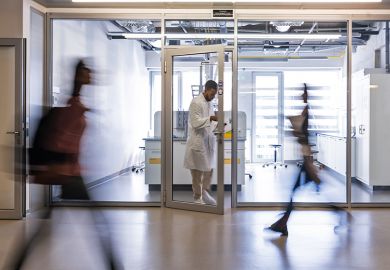Last year, a team at the British Museum and the UK’s Science and Technology Facilities Council led a pioneering study into ancient Egyptian lizard mummies. Using neutron imaging, the team was able to peer inside tiny copper alloy animal coffins that had been sealed in the Nile Delta during the first millennium BC.
Neutron imaging, developed by physicists, has enormous potential to help archaeologists analyse complex objects without causing any damage to them. In this case, it confirmed that the coffins contained bones, likely to be of North African wall lizards, that had been wrapped in textiles as part of religious practices. The work continues, in preparation for an exciting future exhibition on animal mummies.
The UK’s globally important museums are a vital part of its research infrastructure. Indeed, we are collectively missing a trick if we do not maximise the impact of our national museums. There is no point in having extraordinary analytical capabilities without equally extraordinary material for analysis; the UK is very fortunate in having both. Museum objects and new archaeological discoveries are, in some cases, all we know of ancient civilisations.
Also vital is the metadata contained in archives, and efforts are under way to make this more accessible. Towards a National Collection, a five-year project funded by the Arts and Humanities Research Council, supports research that aims to break down barriers between collections such as those held by the Natural History Museum, the British Library and the British Museum. We want to create a single virtual “national collection”, digitally reuniting the original collections of Sir Hans Sloane – which formed the foundational collections of all three institutions – and making them available to all.
As part of this – and in response to the thefts of objects announced last year – the British Museum, of which I am a trustee, has pledged to complete the full digitisation of our collection within five years. This will, for the first time, allow access to the entire collection for all who want to explore it. The aim is to make the British Museum the most viewed, studied and used museum collection in the world. And during this cataloguing and digitising process, we are excavating parts of the collection that have thus far been locked away.
Bringing together objects, archives and incredibly sophisticated analytical equipment allows us to explore collections as we have never done before, looking at difficult subjects and histories. And there are many opportunities for researchers nationally and internationally to get involved.
Indeed, it is an exciting time to do so. The British Museum is part of a renaissance in research across the UK’s gallery, library, archive and museum (GLAM) sector over the past 10 years, supported and enabled by UK Research and Innovation, charitable and other philanthropic funding and initiatives.
We will continue to drive that renaissance over the next decade. As set out in our new research strategy, collaborative research with excellent academic researchers from across the UK and beyond will be at the heart of the British Museum’s work to develop the agenda for future research across the museum sector.
Collaborations with museums provide fertile environments for research training and career development. Research at a museum differs from that at a university. By its very nature, it is interdisciplinary, revealing the complex histories of objects. Hence, it typically requires collaborations between people bringing different expertise and approaches, including craftspeople/makers and experts from source communities.
In 2018, for example, conservators, curators and scientists had the challenge of researching an imposing Tahitian mourning costume. As well as facilitating its display and long-term preservation, their work has transformed our understanding of this culturally important object, opening up new discussions with Polynesian community members and resulting in a long-term loan to the islands.
Another example is the British Museum’s money and medals department. This contains the physical history of the global economy for the past two millennia, offering a mine of interdisciplinary evidence about how governments have tried (and sometimes failed) to create wealth, encourage production and control the balance of trade. It also comprises an iconographic history of ideology – how governments and rulers use images and words.
Research success is measured differently in museums from in universities. It is not about publications, grant income or Research Excellence Framework scores so much as about how well collections are enabled to inspire, change and touch other people’s lives.
In other words, museum research starts from and embodies impact, occasionally literally. Collaborative research with the University of Southampton, for instance, is informing the British Museum’s understanding of how vibration during transport can damage objects, helping us minimise this risk to objects during national and international loans.
And public engagement – local, national and global – accompanies all our research work. The aim is always to exhibit the researched objects and collections and explain these in new ways, including with reference to the people who created them, the environments in which they were fashioned and the circumstances in which they were acquired.
The British Museum is open to everyone. Not only to every member of the public who wants to learn about the history of human civilisation, but also to every researcher who wants to enhance that understanding by making new discoveries about our collections.
Sir Mark Walport is a trustee of the British Museum. He has served as government chief scientific adviser, chief executive of UK Research and Innovation and director of the Wellcome Trust.
POSTSCRIPT:
Print headline: Exhibit A for impact and interdisciplinarity
Register to continue
Why register?
- Registration is free and only takes a moment
- Once registered, you can read 3 articles a month
- Sign up for our newsletter
Subscribe
Or subscribe for unlimited access to:
- Unlimited access to news, views, insights & reviews
- Digital editions
- Digital access to THE’s university and college rankings analysis
Already registered or a current subscriber?









